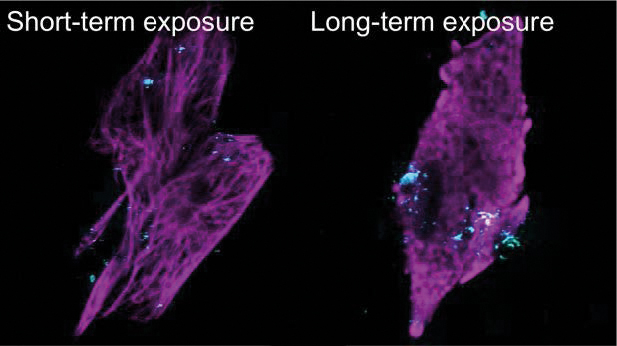Fast and Label-Free Detection of Polluting Carbonaceous Particles: a Gap in the Diagnostic Market
Carbonaceous particle exposure and air pollution in general lead to serious adverse human health effects and pose multiple challenges in terms of exposure, risk and safety assessment.
Highly desirable for quick screening are label-free approaches for detecting these particulates in biological and medical context.
Hasselt University and KU Leuven have developed a new sensitive, label-free and biocompatible technique for the detection of the particles in (non)-biological samples.


COMPELLING RESULTS
Research showed that carbonaceous particles can be easily detected without the need of sample preparation or pretreatment in different biological contexts (see figure for detection in exposed human lung fibroblasts).
Simultaneous detection of cell functioning using various conventional fluorophores and the carbon loading is very flexible. This approach directly puts the location of the particles in their biological context, yielding an extremely fast detection for demanding biomedical research including toxicology and epidemiology.

KEY FEATURES AND ADVANTAGES
- Example body fluid validation: urinary carbon loading as a biomarker for personalized medium-term to chronic exposure to combustion-related ultrafine air pollution.
- Straightforward and flexible technique applicable to various biological and nonbiological samples.
- Applications include imaging and counting in microfluidic systems.
- A high throughput demonstrator is currently in development.
- Strong IP protection extending to at least 2027.
MARKET POTENTIAL
Worldwide, air pollution is responsible for more than 4 million premature deaths, which costs the global economy US$225 billion.
The severity of exposure and the measures to effectively reduce the impact of air pollution requires enhanced probing methods to gain up-to-date knowledge about its impact on human health, ecosystems, environment and climate.
The technique and related results may support an European – or even a global – regulation regarding the emission of black
OUTSTANDING OPPORTUNITY
Patent applications that are available for licensing: WO2017120647 A1.
Hasselt University and KULeuven are searching for interested parties to complete development and commercialization.
RELEVANT PUBLICATIONS
Bove et al. Nano Lett 2016
Saenen et al. Am J Respir Crit Care Med. 2017
Steuwe et al. doi.org/10.1002/jbio.201700233
www.youtube.com/watch?v=cX8uGkeETy0
BUSINESS MANAGER
dr. An Voets

Wil je deze info graag in een pdf? Klik dan hier.
